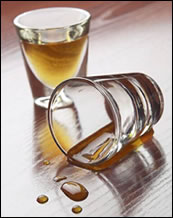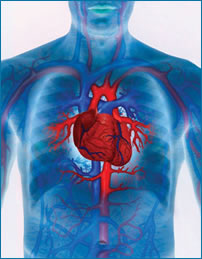 A
growing body of evidence indicates that cardiovascular disease
is more common among HIV positive
people -- and at younger ages -- compared with HIV negative
individuals. However, the relative contributions of inflammation
due to ongoing HIV infection, side effects of ART, and traditional
risk factors such as smoking are not fully understood.
A
growing body of evidence indicates that cardiovascular disease
is more common among HIV positive
people -- and at younger ages -- compared with HIV negative
individuals. However, the relative contributions of inflammation
due to ongoing HIV infection, side effects of ART, and traditional
risk factors such as smoking are not fully understood.
While heavy alcohol consumption is not generally listed among
the most common cardiovascular risk factors, it has been linked
to heart disease in prior studies of the HIV negative general
population.
Matthew Freiberg and fellow investigators with the Veterans Aging
Cohort Study (VACS) Project Team sought to determine whether alcohol
consumption is associated with cardiovascular disease among HIV
positive U.S. veterans.
The researchers analyzed cross-sectional data from 4743 men in
the VACS cohort who reported at least some alcohol use, about
half of whom were HIV positive veterans and half were demographically
similar HIV negative veterans.
Alcohol use
was classified as:
 |
Infrequent
and moderate drinking (14 or fewer drinks per week); |
 |
Hazardous
drinking (either more than 14 drinks per week, or "binge
drinking" of 6 or more drinks on a single occasion at
least once a month); |
 |
Alcohol
abuse or dependence (alcohol use exceeding the hazardous level,
plus other criteria). |
Results
 |
HIV
positive and HIV negative men had similar high likelihood
of problematic alcohol use, including hazardous drinking (33.2%
vs 30.9%) and alcohol abuse or dependence (20.9% vs 26.2%). |
 |
14.6%
of HIV positive men had cardiovascular disease, compared with
19.8% of HIV negative participants. |
 |
Among
the HIV positive men, hazardous drinking was associated with
a significantly higher prevalence of cardiovascular disease
compared with infrequent and moderate alcohol use (odds ratio
[OR] 1.43, or a 43% increase in risk). |
 |
Alcohol
abuse or dependence was also associated with a significantly
higher prevalence of cardiovascular disease compared with
lighter alcohol use (OR 1.55, or a 55% increase). |
 |
Among
only HIV positive men, hazardous drinking increased the risk
of congestive heart failure by 74% and alcohol abuse or dependence
did so by 99%. |
 |
Within
this same group, past alcohol use was associated with a 78%
higher risk of stroke. |
 |
Among
only HIV negative men, the researchers did not see a significant
association between current alcohol use and cardiovascular
disease, but past drinkers had a significantly higher risk
(OR 1.30, or 30% higher). |
 |
For
both HIV positive and HIV negative men, traditional risk factors
and kidney disease predicted cardiovascular disease. |
 |
However,
the greater risk associated with heavy alcohol use among HIV
positive men remained even after adjusting for these other
risk factors. |
 Based
on these findings, the study authors concluded, "Among HIV-infected
men, hazardous drinking and alcohol abuse and dependence were
associated with a higher prevalence of cardiovascular
disease compared with infrequent and moderate drinking even
after adjusting for traditional cardiovascular disease risk factors,
antiretroviral therapy, and CD4 count."
Based
on these findings, the study authors concluded, "Among HIV-infected
men, hazardous drinking and alcohol abuse and dependence were
associated with a higher prevalence of cardiovascular
disease compared with infrequent and moderate drinking even
after adjusting for traditional cardiovascular disease risk factors,
antiretroviral therapy, and CD4 count."
Since the same association did not hold for HIV negative men,
they suggested that heavy alcohol use appears to have a more pronounced
effect on men with HIV. The underlying reasons for this discrepancy
are not clear, but elevated lipid levels associated with heavy
alcohol consumption may play a role. In contrast, various studies
in the HIV negative population indicate that light drinking --
especially wine -- appears to have a protective effect.
University
of Pittsburgh School of Medicine, Pittsburgh, PA; University of
Pittsburgh Graduate School of Public Health, Pittsburgh, PA; Center
for Health Equity Research and Promotion, Veterans Affairs Pittsburgh
Healthcare System, Pittsburgh, PA; Boston University School of
Medicine, Boston, MA; Lexington Veteran Affairs Medical Center
and University of Kentucky Chandler Medical Center, Lexington,
KY; Boston University School of Medicine, Boston, MA; National
Institute on Alcohol Abuse and Alcoholism, National Institutes
of Health, Rockville, MD; Veteran Affairs Connecticut Healthcare
System, West Haven, CT; Yale University School of Medicine, New
Haven, CT.
4/2/10
Reference
MS
Freiberg, KA McGinnis, K Kraemer, and others (VACS Project Team).
The Association Between Alcohol Consumption and Prevalent Cardiovascular
Diseases among HIV-Infected and HIV-Uninfected Men. Journal
of Acquired Immune Deficiency Syndromes 53(2): 247-253 (Abstract).
February 2010.
